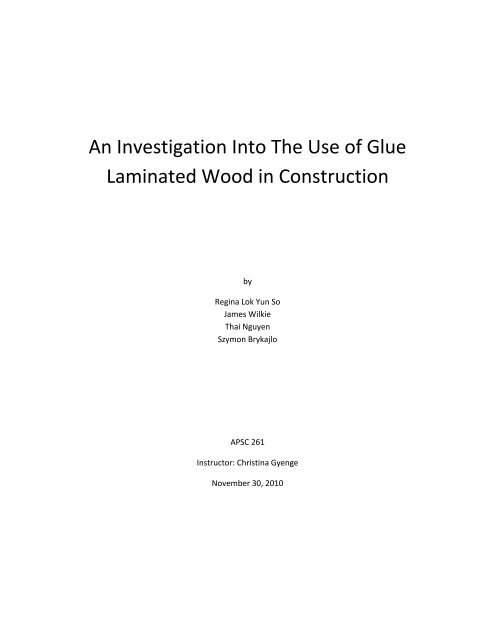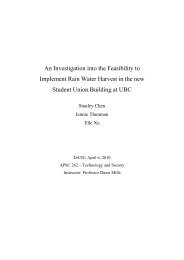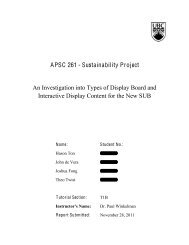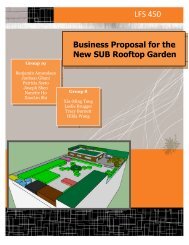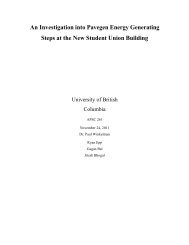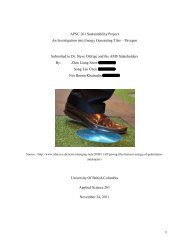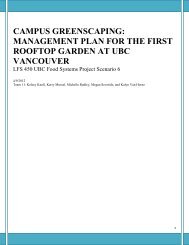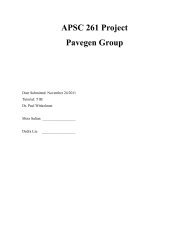An Investigation Into The Use of Glue Laminated ... - My New Sub
An Investigation Into The Use of Glue Laminated ... - My New Sub
An Investigation Into The Use of Glue Laminated ... - My New Sub
Create successful ePaper yourself
Turn your PDF publications into a flip-book with our unique Google optimized e-Paper software.
<strong>An</strong> <strong>Investigation</strong> <strong>Into</strong> <strong>The</strong> <strong>Use</strong> <strong>of</strong> <strong>Glue</strong><br />
<strong>Laminated</strong> Wood in Construction<br />
by<br />
Regina Lok Yun So<br />
James Wilkie<br />
Thai Nguyen<br />
Szymon Brykajlo<br />
APSC 261<br />
Instructor: Christina Gyenge<br />
November 30, 2010
ABSTRACT<br />
This report is a triple bottom line assessment <strong>of</strong>f use <strong>of</strong> glued laminated wood (glulam) in<br />
construction. Its purpose is to evaluate the use <strong>of</strong> glulam for structural elements against<br />
conventional reinforced concrete construction. In particular this report considers the social,<br />
environmental, and economic impacts <strong>of</strong> using glued laminated wood over steel and concrete.<br />
One <strong>of</strong> the advantages <strong>of</strong> glued laminated wood is that it can be built out <strong>of</strong> pine beetle infested<br />
wood without losing its strength properties. If glulam was more widely used as a construction<br />
material, many hectares <strong>of</strong> BC pine forests previously regarded as non-merchantable would<br />
become useful. This could potentially bring back thousands <strong>of</strong> jobs to people in forestry industry.<br />
Studies have shown that people prefer wooden interiors over concrete or steel for their warm and<br />
relaxing feel. To evaluate glulam from the environmental perspective the Life Cycle Assessment<br />
method was used. It was found that total energy use, greenhouse gas index, air pollution index,<br />
solid waste and ecological resource impact use where all the lowest for wood. When considering<br />
the use <strong>of</strong> glulam one should keep in mind that formaldehyde is still the most common glue used<br />
to bond individual parts <strong>of</strong> a glulam beam. Formaldehyde is toxic and at concentrations above<br />
0.1 ppm has adverse effects to human health. More expensive non-toxic resin alternatives are<br />
available. From an economic standpoint, using wood for structural elements <strong>of</strong> multi-story<br />
buildings costs the same or less comparing to a traditional concrete and steel construction. Using<br />
wood could be made cheaper by increasing prefabrication, increasing logistics, and improving<br />
construction process.<br />
Considering that the new sub is designed with sustainability as its primary objective, wood<br />
would be a good material to use for at least some <strong>of</strong> its structural elements. <strong>The</strong> key points to<br />
support this idea are the lowest negative environmental impact according to LCA method, lower<br />
costs <strong>of</strong> construction, and ability to use pine beetle infested timber.<br />
2
TABLE OF CONTENTS<br />
TABLE OF FIGURES .................................................................................................................................. 4<br />
ABSTRACT .................................................................................................................................................. 5<br />
1.0 INTRODUCTION ............................................................................................................................ 6<br />
2.0 SOCIAL IMPACTS OF USING LAMINATED WOOD IN CONSTRUCTION ........................... 7<br />
2.1 USE OF PINE BEETLE INFECTED WOOD.............................................................................. 7<br />
2.2 PINE BEETLE INFESTED WOOD APPLICATION ................................................................. 8<br />
2.3 JOBS AFFECTED BY PINE BEETLE ...................................................................................... 10<br />
2.4 SOCIAL SPACE ......................................................................................................................... 12<br />
3.0 EVIRONMENTAL IMPACTS OF USING LAMINATED WOOD IN CONSTRUCTION ........ 15<br />
3.1 ENERGY CONSUMPTION....................................................................................................... 15<br />
3.2 CARBON DIOXIDE (CO2) EMISSION ................................................................................... 16<br />
3.3 CARBON CYCLE OF WOOD BASED PRODUCT ................................................................. 17<br />
3.4 ADHESIVES USED IN LAMINATED WOOD ........................................................................ 19<br />
3.5 AVAILABLE RESOURCES IN CANADA .............................................................................. 19<br />
3.6 NEW SUB ................................................................................................................................... 20<br />
4.0 ECONOMIC FACTORS OF USING LAMINATED WOOD IN CONSTRUCTION .................. 22<br />
5.0 CONCLUSION ............................................................................................................................... 24<br />
3
TABLE OF FIGURES<br />
FIGURE 1 - PINE BEETLE AFFECTED FORESTS IN BRITISH COLUMBIA ...................................... 8<br />
FIGURE 2 - PINE BEETLE INFESTATION AND PINE TREE REDUCTION IN BRITISH<br />
COLUMBIA ................................................................................................................................................. 9<br />
FIGURE 3 - ROOF OF RICHMOND OVAL DURING CONSTRUCTION ............................................ 11<br />
FIGURE 4 - FINISHED ROOF OF RICHMOND OVAL ......................................................................... 12<br />
FIGURE 5 - IMPORTANCE OF VARIOUS FACTORS THAT SUBJECTS WOULD WANT TO<br />
SPEND TIME IN ........................................................................................................................................ 13<br />
FIGURE 6 - PERCEIVED ATTRIBUTES OF WOOD VERSUS OTHER NATURAL FURNISHING<br />
MATERIALS (1 = MATERIAL POSSESSES ATTRIBUTE, -1 = MATERIAL LACKS ATTRIBUTE)<br />
.................................................................................................................................................................... 14<br />
FIGURE 7 - LCA OF WOOD, STEEL AND CONCRETE ....................................................................... 15<br />
FIGURE 8 - NET CO2 EMISSIONS OF SELECTED BUILDING MATERIALS DURING WHOLE<br />
LIFECYCLE ............................................................................................................................................... 16<br />
FIGURE 9 - CARBON CYCLE OF WOOD AND WOOD BASED PRODUCT ..................................... 18<br />
FIGURE 10 - CANADA’S 401 MILLION HECTARES OF FOREST ..................................................... 20<br />
4
GLOSSARY<br />
Life Cycle assessment (LCA): a technique to assess each and every impact associated with all<br />
the stages <strong>of</strong> a process from cradle-to-grave (i.e., from raw materials through materials<br />
processing, manufacture, distribution, use, repair and maintenance, and disposal or recycling).<br />
Photosynthesis: a process that converts carbon dioxide into organic compounds, especially<br />
sugars, using the energy from sunlight occurring in plants, algae, and many species <strong>of</strong> bacteria,<br />
but not in archaea.<br />
Carbon Cycle: the biogeochemical cycle by which carbon is exchanged among the biosphere,<br />
pedosphere, geosphere, hydrosphere, and atmosphere <strong>of</strong> the Earth.<br />
Formaldehyde: an organic compound with the formula CH 2 O used in many different chemical<br />
compounds. Exposure to formaldehyde is a significant consideration for human health.<br />
5
1.0 INTRODUCTION<br />
<strong>Glue</strong>d laminated wood (glulam) is a type <strong>of</strong> structural timber composed <strong>of</strong> multiple dimensioned<br />
layers <strong>of</strong> wood glued together. Each dimensional piece is usually not thicker 3 inches and its<br />
length varies. Glulam is typically used for ro<strong>of</strong> and floor beams as well as joists. Individual<br />
glulam beams are typically joined by plates, bolts and dawels. Some <strong>of</strong> the primary advantages<br />
<strong>of</strong> glulam over concrete are lower embodied energy and greenhouse gas balance. Some <strong>of</strong> the<br />
primary glulam advantages over solid wood are longevity, strength, ability to make long and<br />
complex shapes.<br />
6
2.0 SOCIAL IMPACTS OF USING LAMINATED WOOD IN CONSTRUCTION<br />
One <strong>of</strong> the most important factors to decide whether laminate wood is a suitable choice as a<br />
construction material is to look at the various impacts it has on the welfare <strong>of</strong> human beings in<br />
society –our personal well being as well as for our general community. <strong>The</strong> following sections<br />
will discuss various aspects concerning the social impacts due to the use <strong>of</strong> laminate wood.<br />
2.1 USE OF PINE BEETLE INFECTED WOOD<br />
<strong>The</strong> primary factor in considering using wood for construction is due to our location where the<br />
lumber industry is one <strong>of</strong> the largest industries in British Columbia. Pine beetle infection is<br />
known to be one <strong>of</strong> the greatest dangers to lodgepole pine forests, with an enormous impact both<br />
socially and economically.<br />
<strong>The</strong> largest outbreak <strong>of</strong> mountain pine beetle as <strong>of</strong> 2007 was recorded at over 10.1 million<br />
hectares out <strong>of</strong> only 14.9 million hectares <strong>of</strong> lodgepole pine forests being affected just in British<br />
Columbia alone. While mature pine contributes to approximately 29% <strong>of</strong> total provincial timber,<br />
40% <strong>of</strong> merchantable pine has been affected by pine beetles. [1] Figure 1 shows a photo <strong>of</strong> the<br />
aerial view <strong>of</strong> the infected forest in British Columbia, and Figure 2 shows the approximate areas<br />
in British Columbia that was infected in the past few years, and the prediction for the next few<br />
years. <strong>The</strong> beetles mass-murder mature healthy trees and leave the dead trees stained with a tint<br />
<strong>of</strong> blue. Due to the blue stain,<br />
7
Figure 1 - Pine beetle affected forests in British Columbia<br />
(http://www.treehugger.com/files/2009/01/time-to-grow-cut-use-wood.php)<br />
these pine beetled affected pine wood was regarded as non-pr<strong>of</strong>itable and useless on the market.<br />
However, the structural properties <strong>of</strong> blue-stained lodgepole pine do not differ much from non-<br />
stained healthy pine wood.<br />
2.2 PINE BEETLE INFESTED WOOD APPLICATION<br />
Due to the increased volume <strong>of</strong> attacked pine lumber, more studies have been done to test the<br />
properties <strong>of</strong> post laminated wood with pine beetle transmitted lodgepole pine. Bending,<br />
toughness, and trust connector tests conducted by Forintek Canada Corp in 2003 shows that there<br />
are no significant differences between beetle infected wood and non-infected wood in terms <strong>of</strong><br />
mechanical properties. [2] In fact, stained laminate posts<br />
8
Figure 2 - Pine beetle infestation and pine tree reduction in British Columbia<br />
(http://www.treehugger.com/files/2007/09/the_pine_beetle.php)<br />
exhibited good performance compared to 140mm x 140mm Select Structural Douglas-fir posts.<br />
Due to the increasing volume <strong>of</strong> affected areas, it is much more sustainable to use the stained<br />
pine wood. If the blue tint may be an issue, there are methods to cover the blue-tint during the<br />
process <strong>of</strong> lamination. <strong>The</strong> extra cost to cover the color can be balanced by the significantly<br />
lower cost <strong>of</strong> pine beetle infected wood as compared to healthy timbers.<br />
As an example, the Richmond Oval, speed skating rink built for Vancouver Winter Olympics<br />
2010, used one million board feet <strong>of</strong> B.C. pine beetle-infected wood to construct one <strong>of</strong> the<br />
longest clear span ro<strong>of</strong>s in North America. It was constructed by undulating linked sections and<br />
has received an award for the use <strong>of</strong> the infected wood in the ceiling construction. <strong>The</strong> blue tint<br />
in the ro<strong>of</strong> during construction (Figure 3) is much more evident as compared to the finished rink<br />
(Figure 4). With the Richmond Oval demonstrating the use <strong>of</strong> laminated pine beetle infected<br />
wood, it is not hard to implement the same concepts for the new SUB project utilizing the<br />
abundance <strong>of</strong> the infected wood.<br />
9
2.3 JOBS AFFECTED BY PINE BEETLE<br />
A report from the Central 1 Credit Union predicts over 11, 250 forestry jobs will be lost due to<br />
the pine beetle infestation. 9500 indirect jobs will also be lost in the BC Interior region. Just like<br />
with the mining boom, many forestry-supported populations have moved elsewhere and it is<br />
expected around 11, 500 homes will become vacant. [3] This is caused by the amount <strong>of</strong> jobs due<br />
to the lack <strong>of</strong> market value for pine beetle infected timber. If there is an increased interest to use<br />
the blue stained pine wood, a lot more jobs can be made available again and less people will<br />
have to relocate due to infestation.<br />
10
Figure 3 - Ro<strong>of</strong> <strong>of</strong> Richmond Oval during construction<br />
(http://www.treehugger.com/files/2009/01/time-to-grow-cut-use-wood.php)<br />
11
Figure 4 - Finished ro<strong>of</strong> <strong>of</strong> Richmond Oval<br />
(http://en.wikipedia.org/wiki/File:Richmond_Olympic_Oval_intern_View.jpg)<br />
2.4 SOCIAL SPACE<br />
Environments with strong wood presence are <strong>of</strong>ten connected to words such as “warm”,<br />
“comfortable”, “relaxing”, “natural”, and “inviting”. In a study by a group <strong>of</strong> pr<strong>of</strong>essors at<br />
University <strong>of</strong> British Columbia, 119 people partake in a three-part experimental study to try to<br />
understand whether wood have an effect on the overall psychological well being <strong>of</strong> humans. [4]<br />
Mentioned in their paper was another study done by Broman in 2000, which found that different<br />
features <strong>of</strong> wood would evoke feelings such as “harmony”, “simplicity”, and “balance” in the<br />
participants asked. In another study in Japan in the early 1990s also showed people find interiors<br />
with higher proportion <strong>of</strong> wood to be more “warm” and “calming”.<br />
12
In their main study, where they showed the 119 participates photos over various photos <strong>of</strong><br />
interiors with different layouts, there were several factors that seem to contribute to higher<br />
scores. <strong>The</strong>y tend to have larger windows, with a nature view visible outside the window. <strong>The</strong><br />
two highest rated living rooms have a heavy wood presence and with very little synthetic<br />
materials. Most <strong>of</strong> the top rated (photos <strong>of</strong>) rooms also had wooden floors.<br />
Figure 5 outlines the importance <strong>of</strong> various factors in a room the participants prefer to spend time<br />
in. Although wood, explicitly listed, isn’t ranked very high, it definitely contributes the top few<br />
factors.<br />
Figure 5 - Importance <strong>of</strong> various factors that subjects would want to spend time in<br />
It is important to note that since “color” is important, if pine beetle infected wood is to be used,<br />
the blue tint may become a big factor to consumer’s preference. Lighter colored wood would<br />
likely cause a room looking “brighter”, which will contribute to the 2 nd ranked “lighting” and 4 th<br />
ranked “natural lighting” factor. Although this report focuses on the use <strong>of</strong> laminate wood in<br />
construction and not interior design, it is likely beams and the ceiling or ro<strong>of</strong> would be visible in<br />
the finished building. In figure 6, it is evident most think <strong>of</strong> wood as the warmest, most natural,<br />
homey, and relaxing as compared to ceramic, stone and leather materials. A similar response<br />
when comparing wood with plastic and glass as well as comparing wood with painted surface<br />
13
and wallpaper. Over 75.6% <strong>of</strong> the 119 respondents have positive feedback about a room<br />
containing a lot <strong>of</strong> wood details and furnishings.<br />
This study being done locally helps us put in perspective the amount <strong>of</strong> people who would likely<br />
find an environment with more wood presence to be more “homey”, “warm” and “relaxing”.<br />
This is important because the new SUB is to be a central space for students, staffs, and visitors<br />
and what they feel about the building will be one <strong>of</strong> the priorities in deciding the building design.<br />
Figure 6 - Perceived attributes <strong>of</strong> wood versus other natural furnishing materials (1 = material possesses<br />
attribute, -1 = material lacks attribute)<br />
14
3.0 EVIRONMENTAL IMPACTS OF USING LAMINATED WOOD IN<br />
CONSTRUCTION<br />
3.1 ENERGY CONSUMPTION<br />
Total energy consumption is the first factor to consider when evaluating the environmental<br />
aspects <strong>of</strong> a product. A systematic way to do this is to use Life Cycle Assessment (LCA). LCA<br />
gives a scientific measurement <strong>of</strong> environmental impacts <strong>of</strong> a product throughout its entire life<br />
span from production stage to in-use stage and eventually end <strong>of</strong> life stage including disposal,<br />
reuse or recycling [5]. Comparing LCA <strong>of</strong> common construction materials such as steel, concrete<br />
and wood helps determine the friendliness <strong>of</strong> a material to the environment. As a result, wood<br />
surpasses steel and concrete at all criteria. In particular, wood consumes less total energy<br />
meaning that solid waste and ecological impact are reduced. Less impacts on environment<br />
essentially allows the achievement <strong>of</strong> lower greenhouse gas index and air pollution index. See<br />
Figure 7 below:<br />
Figure 7 - LCA <strong>of</strong> wood, steel and concrete<br />
(http://www.cwc.ca/NR/rdonlyres/4749BE13-2089-4A49-87C8-55E40257EDD7/0/Canadian_Wood.pdf)<br />
15
3.2 CARBON DIOXIDE (CO2) EMISSION<br />
One <strong>of</strong> the most significant and distinctive advantages <strong>of</strong> using constructional wood over other<br />
materials is the reduction <strong>of</strong> CO2 emission. As mentioned in previous section, LCA is again used<br />
for CO2 emission <strong>of</strong> wood in three main phases: production phase, in-use phase and end <strong>of</strong> life<br />
phase. At production phase, wood generally requires less energy for extraction, production and<br />
transportation than that <strong>of</strong> other materials. <strong>The</strong>refore, less CO2 is emitted. In addition, the sink<br />
effect [6] <strong>of</strong> wood gives negative net emission. <strong>The</strong> in-use phase considers how much energy is<br />
needed to operate and maintenance the product. Fortunately, wood can be a really good thermal,<br />
acoustic and moisture insulator [7]. Because the majority <strong>of</strong> energy is spent on the operating<br />
period, a good design can significantly reduce energy consumption and at the same time give a<br />
comfortable living condition. <strong>The</strong> less energy is required, the less CO2 is emitted. Finally at the<br />
end <strong>of</strong> life phase, wood can be used as a carbon neutral energy source meaning that it simply<br />
returns the CO2 originally removed from the atmosphere. <strong>The</strong> net CO2 emissions <strong>of</strong> wood and<br />
other building materials are shown in Figure 8 below.<br />
Figure 8 - Net CO2 emissions <strong>of</strong> selected building materials during whole lifecycle<br />
(http://www.roadmap2010.eu/wisd/pdfs/30-45.pdf)<br />
16
Wood and wood based products play an important role in attempting to slow down global<br />
warming. In nature, trees take in CO2 and release oxygen during photosynthesis process. When<br />
trees are made into wood, they still hold on to the CO2 absorbed previously and trap it inside for<br />
a long time. In contrast, other building materials require a large amount <strong>of</strong> energy for production<br />
which adds more CO2 to the environment. A question would be asked is how much CO2 can be<br />
saved using wood. <strong>The</strong> answer is quite impressive: 0.75 to 1 tonne <strong>of</strong> CO2 is saved from<br />
substituting a cubic metre <strong>of</strong> wood for concrete blocks or bricks [8]. <strong>The</strong>refore, using wood and<br />
wood based products does help tackle climate change.<br />
3.3 CARBON CYCLE OF WOOD BASED PRODUCT<br />
One crucial factor to determine if a material is environmental friendly is its recyclability. Wood,<br />
in fact, is much easier to recycle compared to other building materials. Depending on the<br />
conditions, wood can be re-used, recycled or used as carbon neutral energy source. Figure 9<br />
below summarizes life cycle <strong>of</strong> wood based products.<br />
17
Figure 9 - Carbon cycle <strong>of</strong> wood and wood based product<br />
(http://www.roadmap2010.eu/wisd/pdfs/46-57.pdf)<br />
During its closed-cycle life, wood minimizes CO2 emission and maximizes usage with little<br />
energy consumption. For example, a wooden structure after many years <strong>of</strong> use can be re-used in<br />
a new building, either intact or resized. Generally, the portion <strong>of</strong> re-usable wood with or without<br />
repairs in existing structure is significant. A recent study in Europe shows that over half <strong>of</strong> 44000<br />
tonne <strong>of</strong> building and demolition wood could be re-used, 6700 tonne as sawn timber and 16000<br />
recycled into wood based panels [9]. In case the wood structures are not good enough to re-use,<br />
they can be recycled into other products. <strong>The</strong> recycled content from manufactured products has<br />
increased over time. Nowadays, numerous products are made from recovered wood including<br />
wood-plastic composites, animal bedding, surfacing etc [9]. Nevertheless, only high quality<br />
recovered wood can be used because <strong>of</strong> health concerns for all customers. Lastly, if those wood<br />
based products can be neither re-used nor recycled, they are then used as a substitute for fossil<br />
fuel. <strong>The</strong> energy coming out from this source is actually clean and does not produce additional<br />
CO2 other than the CO2 inside the wood originally.<br />
18
3.4 ADHESIVES USED IN LAMINATED WOOD<br />
In order to maximize the use <strong>of</strong> wood in construction, laminated wood has been introduced.<br />
<strong>Laminated</strong> wood is engineered wood which provides a much higher degree <strong>of</strong> dimension and<br />
quality controllability as compared to natural wood. It consists <strong>of</strong> multiple layers glued together<br />
by some adhesives and is designed to meet application specific requirements [10]. Several types<br />
<strong>of</strong> adhesives have been used to strengthen wood bonding. <strong>The</strong> most common ones are all derived<br />
from formaldehyde which is known to be toxic. Studies show that laminated veneer lumbers with<br />
Urea-formaldehyde has the best performance on bonding strength and dimensional stability [11].<br />
However, there have been many health concerns with exposure to formaldehyde. Formaldehyde<br />
emission from formaldehyde based resins used for production <strong>of</strong> laminated wood is a real thread<br />
for both workers and consumers. At concentration above 0.1 ppm in air formaldehyde can irritate<br />
eyes and mucous membranes, resulting in watery eyes and when inhaled it cause headaches,<br />
difficulty breathing and asthma symptoms [12]. <strong>The</strong>refore, this issue should be taken into<br />
account seriously when designing for the new SUB.<br />
3.5 AVAILABLE RESOURCES IN CANADA<br />
<strong>An</strong>other reason to support the use <strong>of</strong> wood in construction is the availability <strong>of</strong> natural resources.<br />
In fact, Canada has 10% <strong>of</strong> total forest cover in the world, more than any other country [8].<br />
Abundant supply means no need for importing which retains affordable prices. With enhanced<br />
laws and regulations, only less than one percent <strong>of</strong> managed forest is harvested every year and<br />
those areas that are logged must be promptly regenerated. Overall, deforestation rate has been<br />
virtually zero for more than 20 years [8]. Breakdown <strong>of</strong> Canada’s forest cover is shown in Figure<br />
10 below.<br />
19
3.6 NEW SUB<br />
Figure 10 - Canada’s 401 million hectares <strong>of</strong> forest<br />
(http://www.bcforestinformation.com/assets/pdf/tackle-climate-change.pdf)<br />
<strong>The</strong> selection <strong>of</strong> building material for the new SUB is an intensive work <strong>of</strong> combining all social,<br />
environmental and economical factors. In terms <strong>of</strong> environmental aspect, laminated wood seems<br />
to be a very promising candidate. However, there are some disadvantages <strong>of</strong> using laminated<br />
wood in construction. Because it does not have a strong mechanical performance as concrete and<br />
steel, it is obvious that the new SUB can not be built with 100% laminated wood. Only a certain<br />
parts <strong>of</strong> the new SUB should laminated wood. <strong>An</strong>other concern is the public health when<br />
students and staffs are potentially exposed to formaldehyde emission. <strong>The</strong> possible solution is to<br />
use a non formaldehyde based resin. For example, Methylene diphenyl diisocyanate (MDI) or<br />
20
polyurethane (PU) resins are expensive, generally waterpro<strong>of</strong>, and do not contain formaldehyde<br />
[10]. In addition, there have been recent developments <strong>of</strong> eco-efficient bio-based adhesives such<br />
as tannin, lignin, protein, carbohydrate and unsaturated oil adhesives [13]. In conclusion,<br />
laminated wood is an environmentally friendly building material for the new SUB.<br />
21
4.0 ECONOMIC FACTORS OF USING LAMINATED WOOD IN<br />
CONSTRUCTION<br />
<strong>Laminated</strong> wood is analogous to engineered wood. It uses wood and adhesive to create a<br />
structural material superior in strength and durability to plain timber.It is cheaper to build using<br />
laminated wood products than it is to use timber due to the following factors.<br />
It is comprised <strong>of</strong> multiple smaller pieces, as opposed to a single slab, allowing more <strong>of</strong> a log to<br />
be used in the production, as well as small logs or slightly bent logs. As the supply <strong>of</strong> raw<br />
material capable <strong>of</strong> producing a product increases, the price <strong>of</strong> the material drops, as does the<br />
price <strong>of</strong> the product.<br />
It is stronger. Using the volume <strong>of</strong> material in a solid beam, a much stronger glulam beam can be<br />
produced. In solid timber, the grain direction, knots and flaws in the wood cannot be controlled,<br />
so more wood must be used to create a structure <strong>of</strong> sufficient strength. <strong>Laminated</strong> wood is<br />
comprised <strong>of</strong> layers <strong>of</strong> wood that has the grain oriented along the direction in which the beam is<br />
loaded. Even if there are knots or weak points, they are only present in the defective layer. This<br />
comparison is analogous to solid glass to fibreglass. A crack in a pane <strong>of</strong> glass will spread and<br />
shatter the glass, whereas if a single strand in fibreglass breaks, the rest <strong>of</strong> the fibres bear the load<br />
and preventing failure. If a single laminar layer fails due to an impurity in the wood, only that<br />
layer is compromised.<br />
<strong>The</strong> shape <strong>of</strong> the laminated structure is more flexible in design. Wooden I-beams can maximise<br />
the moment <strong>of</strong> area for the amount <strong>of</strong> wood used, reducing the amount <strong>of</strong> wood needed, and<br />
reducing cost. <strong>The</strong> strength <strong>of</strong> the wood can also be distributed throughout the shape: high<br />
quality wood is used for the outside layers that are under tension or compression, and lower<br />
quality (and thus cheaper) wood is used in the center [14].<br />
<strong>The</strong> other economic factors for using glulam in construction are based on the input energy<br />
towards producing a comparable product to that <strong>of</strong> concrete or steel. <strong>The</strong> use <strong>of</strong> wood in<br />
construction instead <strong>of</strong> steel costs less due to labour savings and energy savings during<br />
construction. From the processes where raw material is extracted from the earth, wood uses<br />
between 44% and 85% less energy than steel, and 70-87% less than concrete [15]. According to<br />
22
a study performed by [16], a house made with steel used $14,895 worth <strong>of</strong> steel framing and<br />
fasteners, and $12,100 worth <strong>of</strong> labour, whereas a house made <strong>of</strong> wood uses $16,675 worth <strong>of</strong><br />
wood and fasteners, and $9062 worth <strong>of</strong> labour for the framing. <strong>The</strong> framing <strong>of</strong> the steel house<br />
cost $1,258 or 4.9% more than that <strong>of</strong> the wood house.<br />
In terms <strong>of</strong> heat conducted through the metal vs. through the wood, the wood house had a heat<br />
index (UAthermal) <strong>of</strong> 282BTU/hr/degF, whereas the steel house had an index <strong>of</strong><br />
293BTU/hr/DegF. This 11 BTU/Hr/DegF translates to 28.2kWh/degF. At $0.08 per kWh, and an<br />
average temperature difference <strong>of</strong> 15 deg F (indoor temperature: 65, outdoor: 50) the annual<br />
energy saving <strong>of</strong> a wood house would be $33.85 compared to living in a steel framed house.<br />
From an economic standpoint, using wood has very few drawbacks. It uses less energy compared<br />
to other building materials, it requires less labour to construct an equivalent building, and it<br />
provides better insulation than steel construction.<br />
23
5.0 CONCLUSION<br />
Considering that the new sub is designed with sustainability as its primary objective, wood<br />
would be a good material to use for at least some <strong>of</strong> its structural elements. <strong>The</strong> key points to<br />
support this idea are the lowest negative environmental impact according to LCA method, lower<br />
costs <strong>of</strong> construction, and ability to use pine beetle infested timber.<br />
24
REFERENCES<br />
[1] J. Axelson, “Influence <strong>of</strong> fire and mountain pine beetle on the dynamics <strong>of</strong> lodgepole<br />
pine stands in British Columbia, Canada”, Forest Ecology and Management, vol. 257, no.<br />
9, April 16 , pp. 1874-1882, 2009.<br />
[2] F. Lam, J. Gu, and I. Zaturecky, “Performance <strong>of</strong> posts laminated with mountain pine<br />
beetle transmitted blue-stained lodgepole pine”, Forest Products Journal, vol. 56, no. 9,<br />
Sep., pp. 60-64, 2006.<br />
[3] Pine beetle to consume B.C. jobs: report. Retrieved Nov 20 th 2010 at:<br />
http://news.ca.msn.com/money/article.aspx?cp-documentid=24945726<br />
[4] J. Rice, R. A. Kozak, M. J. Meitner, D. H. Cohen, “Appearance Wood Products and<br />
Psychological Well-Being”, Journal Wood and Fiber Science, vol. 38, no. 4, Oct., pp.<br />
644-659, 2006.<br />
[5] Canadian Wood Council (2009), Canadian Wood. Renewable by Nature. Sustainable by<br />
Design. Retrieved Oct 20 th 2010 at: http://www.cwc.ca/NR/rdonlyres/4749BE13-2089-<br />
4A49-87C8-55E40257EDD7/0/Canadian_Wood.pdf<br />
[6] How wood products help slow Global Warming. Retrieved Oct 20 th 2010 at:<br />
http://www.roadmap2010.eu/wisd/pdfs/30-45.pdf<br />
[7] <strong>The</strong> benefit <strong>of</strong> using wood. Retrieved Oct 20 th 2010 at:<br />
http://www.roadmap2010.eu/wisd/pdfs/58-67.pdf<br />
[8] Canadian Wood Council (2009), Canadian Wood. Tackle Climate Change, <strong>Use</strong> Wood.<br />
Retrieved Oct 20 th 2010 at: http://www.bcforestinformation.com/assets/pdf/tackle-<br />
climate-change.pdf<br />
25
[9] <strong>The</strong> eco-cycle <strong>of</strong> wood and wood based-products. Retrieved Oct 20 th 2010 at:<br />
http://www.roadmap2010.eu/wisd/pdfs/46-57.pdf<br />
[10] Engineered Wood. Retrieved Nov 24 th 2010 at:<br />
http://en.wikipedia.org/wiki/Engineered_wood<br />
[11] B. Uysal, "Bonding strength and dimensional stability <strong>of</strong> laminated veneer lumbers<br />
manufactured using different adhesives after the steam test," International Journal <strong>of</strong><br />
Adhesion and Adhesives, vol. 25, no. 5, Oct., pp. 395-403, 2005.<br />
[12] Formaldehyde. Retrieved Nov 24 th 2010 at: http://en.wikipedia.org/wiki/Formaldehyde<br />
[13] A. Pizzi, “Recent developments in eco-efficient bio-based adhesives for wood bonding:<br />
opportunities and issues,” J. Adhesion Sci. Technol., vol. 20, no. 8, pp. 829-846, 2006.<br />
[14] Camille A. Issa, Ziad Kmeid, "Advanced Wood Engineering: Glulam Beams",<br />
Construction and Building Materials, Vol. 19, 2005 pp.100-102<br />
[15] <strong>An</strong>n Kristin Petersen, Birger Solberg, "Environmental and Economic Impacts <strong>of</strong><br />
<strong>Sub</strong>stitution Between Wood Products and Alternative Materials: A Review <strong>of</strong> Micro-<br />
level <strong>An</strong>alyses from Norway and Sweden," Forset Policy and Economics, Vol. 7, No. 3,<br />
2005<br />
[16] NAHB Research Center, inc. “Steel vs. Wood: Cost and Short Term Energy Comparison”<br />
Prepared for <strong>The</strong> U.S Department <strong>of</strong> Housing and Urban Development Offce <strong>of</strong> Policy<br />
Development and Research, Washington, DC, 2001.<br />
26


